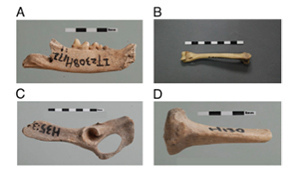A study conducted by researchers at the Chinese Academy of Sciences has produced the first direct evidence for the processes of cat domestication.
Led by Yaowu Hu, he and his colleagues analyzed eight bones from at least two wild cats excavated from the site of the ancient Chinese village of Quanhucun, using radiocarbon dating and isotopic analyses of carbon and nitrogen traces in the bones of the cats. The analysis showed that the cats were preying on animals that lived on farmed millet — probably rodents. Archaeological evidence indicated that the village farmers had problems with rodents in the grain stores. In essence, the cats and the villagers had developed a kind of symbiotic relationship.
“Results of this study show that the village of Quanhucun was a source of food for the cats 5,300 years ago, and the relationship between humans and cats was commensal, or advantageous for the cats,” said study co-author Fiona Marshall, PhD, a professor of archaeology in Arts & Sciences at Washington University in St. Louis. “Even if these cats were not yet domesticated, our evidence confirms that they lived in close proximity to farmers, and that the relationship had mutual benefits.”
_______________________________________________________________________________________________________________________
Above: Field specimens from the site of Quanhucun showing key body parts and the presence of an aged animal with worn dentition. (A) Left mandible with worn fourth premolar and first molar; (B) right humerus; (C) left pelvis; (D) left tibia. Credit: Courtesy of PNAS
_________________________________________________________________________________________
While it often has been argued that cats were attracted to rodents and other food in early farming villages and domesticated themselves, until now, there has been little evidence for this theory.
Other clues gleaned from the Quanhucun food web suggest the relationship between cats and humans had begun to grow closer. One of the cats was aged, showing that it survived well in the village. Another ate fewer animals and more millet than expected, suggesting that it scavenged human food or was fed.
Cat remains rarely are found in ancient archaeological sites, and little is known about how they were domesticated. Cats were thought to have first been domesticated in ancient Egypt, where they were kept some 4,000 years ago, but more recent research suggests close relations with humans may have occurred much earlier, including the discovery of a wild cat buried with a human nearly 10,000 years ago in Cyprus.
Recent DNA studies suggest that most of the estimated 373 million domestic cats* now living around the globe are descendants most directly of the Near Eastern Wildcat, one of the five Felis sylvestris lybica wildcat subspecies still found around the Old World.
Marshall, an expert on animal domestication, said there currently is no DNA evidence to show whether the cats found at Quanhucun are descendants of the Near Eastern Wildcat, a subspecies not native to the area. If the Quanhucun cats turn out to be close descendents of the Near Eastern strain, it would suggest they were domesticated elsewhere and later introduced to the region.
“We do not yet know whether these cats came to China from the Near East, whether they interbred with Chinese wild-cat species, or even whether cats from China played a previously unsuspected role in domestication,” Marshall said.
This question is now being pursued by researchers based in China and in France.
Details of the study have been published in the early online publication, PNAS (Proceedings of the National Academy of Sciences) during the week of Dec. 16, 2013.
______________________
Other members of the research team included Xianglong Chen, Changsui Wang and Liangliang Hou, all affiliated with the Chinese Academy of Sciences’ Key Laboratory of Vertebrate Evolution and Human Origins and the Institute of Vertebrate Paleontology and Paleoanthropology; Songmei Hu, of the Archaeological Research Institute of Shaanxi Province, Xi’an, China; and Xiaohong Wu, of the Department of Archaeology, Peking University, in Beijing.
______________________
Source: Adapted and edited from a press release of Washington University in St. Louis.
*https://worldanimalfoundation.org/cats/how-many-cats-are-in-the-world
Cover Photo, Top Left: The Near Eastern Wildcat, native to Western Asia and Africa, considered the primary ancestor of all domestic cats now living around the globe. Credit: Wikimedia Commons
_____________________________________






